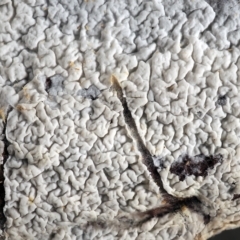Ceraceomyces sp.
The fruitbody is a sheet-like growth that appears on the underside of dead wood lying on the ground. Depending on the species, the surface of the fruitbody may be smooth and flat or have a dense, maze-like wrinkling (a surface technically described as merulioid) and may be white, cream, yellow, pale brown to violaceous-brown. Between the fruitbody surface and the dead wood there is a layer with a distinctly different texture. This layer (or subiculum) resembles thickish cobweb. Overall, the fruitbody is rather flimsy, is fairly loosely attached to the wood and has a somewhat waxy consistency.
In some species where the fruitbodies are merulioid, the surface becomes smooth when dry.
Look-alikes
There are many fungi in which the fruitbody consists of a smooth, flat surface over a cobwebby subiculum and identification to genus usually relies on the study of microscopic features.
Fruitbodies of Athelia species consist of sheet-like growths on a cobwebby subiculum, are loosely attached and a species or two may be merulioid – but don’t have a waxy consistency.
There are some other genera with merulioid fruitbodies but these are mostly robust and well-attached to their woody substrate. In the Canberra region the commonest is probably Byssomerulius corium, in which a well-developed fruitbody is often orange (except for the white margin) or may have shelf-like outgrowths at the edges (rather than being just a sheet-like growth on the wood). Furthermore, the fertile surface ranges from merulioid to pored.
Ceraceomyces sp. is listed in the following regions:
Canberra & Southern Tablelands
Species information
- Ceraceomyces sp. Scientific name
- Common name
- Not Sensitive
- Unknown
- Unknown
- Machine learning






